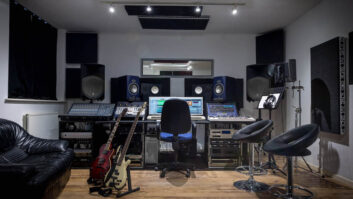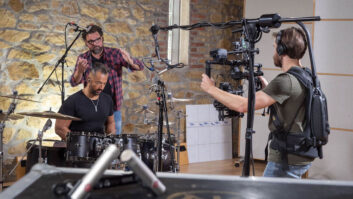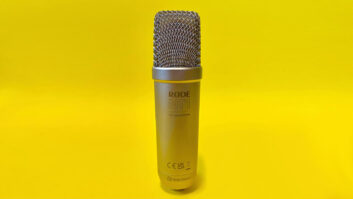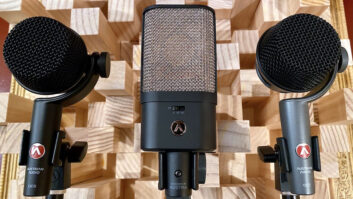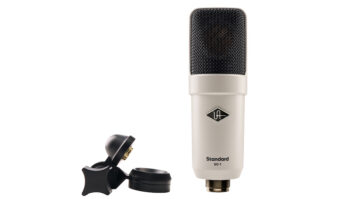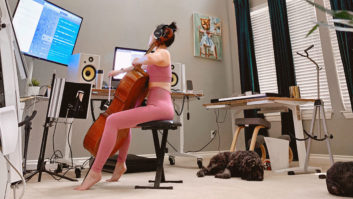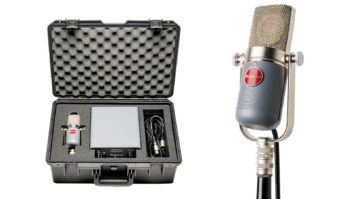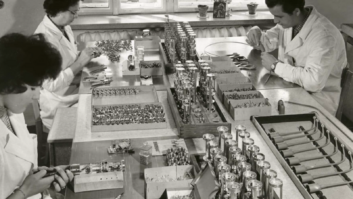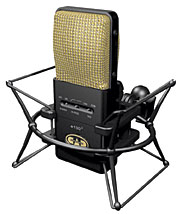
Researching some four-dozen new large-diaphragm microphones that
have recently come to market is the gearhead’s version of a kid in a
candy store. Do you really need another 1-inch diaphragm condenser mic
for vocals, acoustic guitar, drum overheads, horns or piano? Depending
on your studio’s allowance, that’s like asking a 10-year-old to explain
the logic in buying another candy bar. The kids might not agree, but
your next recording application stands to benefit far more from buying
one of the following microphones than simply downing another Snicker’s
bar. Getting a new mic and a Snicker’s is, of course, the best way to
go.
In compiling this article, Mix talked to more than 40
microphone manufacturers and, based on the preponderance of new product
offerings, the mic market appears to be healthy. Increasing competition
and overseas manufacturing are making this a more difficult market for
many. Fortunately, for studio owners, engineers, producers, musicians,
voice-over specialists and anyone with at least $99 to spend on a new
mic, it’s a buyers market: The competition means better gear and more
options. Considering the passionate devotion to excellence displayed by
every mic manufacturer we spoke with, it’s no wonder that, thanks to
their pursuits, we all sound a lot better these days. So here —
listed alphabetically by manufacturer—is what’s new since January
of 2002.
ADK Microphones (www.adkmic.com) added three new large-diaphragm
offerings to its mic cabinet since 2002. The A-48 Vintage Valve
($1,295) is a Class-A, discrete tube condenser that features nine
remotely variable polar patterns, and transverse-mounted 12AX7 valve
and dual 5-micron, 1.07-inch diaphragms. A premium flight case and
multipin cable are included. New from the Area 51 family is the ADK ST
($795), a switchable, tri-pattern, Class-A FET condenser design with
-10dB pad and highpass filter controls; and the Model S “Vienna
Edition” ($595), a high-SPL-handling, fixed cardioid condenser
with -18dB pad and HP filter switches, a 1.07-inch diaphragm and
totally upgraded “JP Mod” Class-A discrete electronics. The
Vienna takes up to 135dB SPL, which makes it useful for live recording
and studio applications, and will be followed by the company’s
“Hamburg Edition” this fall.
AKG‘s (www.akgusa.com) C 414 B-ULS/SE Special Stereo Set
has a nickel finish like the original 1976-1986 C 414 EB, but pairs the
classic CK12 capsules with modern UltraLinear Series electronics. The
two-mic set with case, shock-mounts, stereo bar and windscreens is
$2,100.
New from Apex Electronics (www.apexelectronics.com) is the Model 410 ($249,
including cat’s cradle shock-mount, windsock and flight case). This
cardioid-pattern condenser features switchable -6dB, 100Hz
low-frequency cut-off and a 1-inch diameter capsule. Frequency response
is 40 to 19k Hz, maximum SPL is 135 dB (1 kHz @ 0.5% THD), input
sensitivity is -37 dB @ 1 kHz, and signal-to-noise ratio is better than
73 dB. A -10dB output pad switch is included.
Reviewed in last month’s Mix, Audio-Technica‘s (www.audiotechnica.com) $599 AT3060 is a tube
condenser mic with a large coupling transformer for enhanced
low-frequency linearity. The 3060, which works on 48-volt DC phantom
power and captures a dynamic range of 50 to 16k Hz, features a
shock-mounted tube assembly for dampening mechanically coupled
vibrations and a precision-machined, nickel-plated brass body. Included
are the AT8458 shock-mount and protective pouch.
The $799 SCX-25 from Audix (www.audixusa.com) is a large-diaphragm condenser
incorporating a unique suspension system that’s shock-mounted within a
machined brass ring. Here, the capsule is completely isolated from the
mic body and electronics. Frequency response is 20 to 20k Hz, dynamic
range is 124 dB, and SPL handling is 138 dB; the mic’s miniaturized
preamp circuitry is housed in a svelte 4-inch body. A foam-lined wood
carrying case and mic clip are standard accessories.
Behringer‘s (www.behringer.com) B-2 Pro Dual-Diaphragm Studio
Condenser Microphone is an affordable ($189.99) studio mic with a
1-inch, gold-sputtered, dual-diaphragm capsule and 20 to 20k Hz
frequency response (with a slight boost in the presence range).
Selectable omnidirectional, figure-8 and cardioid patterns, switchable highpass filter and a -10dB pad switch are offered on the B-2 Pro,
along with carry case, shock-mount and windscreen. Switchable LF
roll-off and input attenuation are also included on this
satin-nickel-finished mic.
The latest studio condenser from BLUE (www.bluemic.com) is
the distinctive silver and sparkly black-colored Baby Bottle. Billed as
a smaller, more affordable version of the company’s flagship
multicapsule Tube Bottle, the Baby Bottle is quite different. The Baby
Bottle is not a tube mic; instead, it uses solid-state, Class-A
discrete circuitry with a transformerless output. The Baby Bottle has a
cardioid, 6-micron condenser capsule and retails at $649; custom
shock-mount and metal-mesh windscreen are optional.
Brauner‘s (dist. by Transamerica Audio Group, www.transaudiogroup.com) latest are the Phantom C
($1,750) and Valvet Voice ($2,800). The Phantom C is the company’s
first nontube (FET) large-diaphragm mic offering and retains the
quality and look of the Brauner VM1. This fixed-cardioid pattern,
phantom-powered mic has been re-tuned for vocal use where more
proximity effect and less sibilance are required. The Phantom C sports
8dBa self-noise and 142dB max SPL, and includes carry case and
shock-mount. The company’s Valvet Voice, which offers cardioid polar
response with selectable phase-invert, hard-ground, soft-ground or
ground-lift controls, is another Brauner tube mic, also fine-tuned for
vocal applications. Class-A amplifiers, custom-built Lundahl
transformers and JAN tubes are included.
The second-generation Equitek2 line of servo-condenser microphones
from CAD Microphones (www.cadmics.com) includes the new e1002 ($399 with
case and shock-mount). Unlike most FET designs, the e1002 does not use
discrete circuitry, instead opting for high-speed op amps that are
individually laser trimmed and employed to handle a large amount of
negative feedback and reduce nonlinearity. Sharing the same
side-address, supercardioid electret capsule as the e2002, the e1002
has a single capsule. A 10 to 18k Hz bandwidth, high-SPL capability
(148dB SPL with pad), dual-cantilevered capsule shock isolators and a
20dB noncapacitive pad are included, as is an internal power system
that supplies far more current than phantom power alone.
Carvin‘s (www.carvin.com) CM-87S—the company’s latest
studio condenser—is $299.95, with oxygen-free, 30-foot cable and
custom aluminum flight case. The mic features a cardioid pattern,
gold-sputtered 6-micron element, FET electronics, a -10dB pad switch
and a low-cut switch to remove rumbling, all suspended within a
machined casing. Specs include a high-SPL rating of 145 dB (with -10dB
pad).
DPA Microphones‘ (www.dpamicrophones.com) 4041-T, 4041-S and 4041-SP
($2,990/each) are the company’s latest large-diaphragm omni condensers
based on the 4041 body. The 4041-S and phantom-powered 4041-SP are
solid-state designs that offer the 4041 line’s maximum flexibility in
preamp options when miking vocals, strings or other acoustic
instruments with large dynamics. The SP low self-noise is typically 8
dB (A). The 4041-S uses the company’s MMP4000-S solid-state preamp,
and, like the output stage of the 4041-T’s tube preamp, the transistor
output stage is driven as a Class-A, unity-gain impedance converter.
The 4041-T (130V) uses the MMP4000-T preamp and incorporates a pentode
vacuum-tube driven as a cathode follower in a Class-A, unity-gain
output stage.
The vintage-inspired $699 GT Model 1b and $399 GT Model 1b-FET from
Groove Tubes (www.groovetubes.com, dist. by M-Audio) are part of
a full redesign of the original GT mics, although the company’s
1.1-inch, 3-micron “Disk” diaphragm design is still
implemented in each. More recent GT releases are the MD1b-FET ($399)
and MD1b Tube ($699), both revamped versions of the company’s original
MD1 condensers that debuted 11 years ago. The Tube now sports the
larger 1.1-inch diaphragm and includes a JAN spec tube, as well as
hard-mount and shock-mount, power supply and cable. The MD1b-FET is a
Class-A reissued version of the MD1.
Josephson Engineering‘s (www.josephson.com) top-of-the-line Series Seven
family of variable polar-pattern mics use the company’s
ultrathin-diaphragm design and a multiple capsule system. The C700A
($4,500 with Fiberglas case) comes with a dual-diaphragm element and a
smaller omnidirectional capsule. Fed to a mixer, both outputs allow
engineers to select any directional pattern from omni to figure-8 at
the console, or both signals can be recorded on different tracks and
the pattern selection done in mixdown. A stereo version (C700S; $6,500)
has two pressure-gradient capsules placed at right angles with an omni capsule in the middle so that any coincident-stereo pickup can be
synthesized at the mixer.
Korby Audio Technologies‘ (www.korbyaudio.com) four-head mic system, the Model
10 ($3,200 with one cap; $6,000 with all four), is aptly referred to as
The Convertible. The first available amplifier body in the series is
the Model 10, which contains electronics based around a 5703 vacuum
tube. Sold exclusively by Vintage King Audio, The Convertible is an
interchangeable mic capsule system packaged in a powder-coated cylinder
that’s color-coded to designate model number and amplifier electronics.
The capsule assembly units are housed in a sturdy, bright nickel plate
and mesh-grille assembly. Four capsules—based on the Neumann U47,
Elam 251, AKG C-12 and a custom-modified version of the Neumann
U67—are currently available, with other models in
development.
The long-popular L47MP from Lawson Microphones (www.lawsonmicrophones.com) recently received some
significant upgrades. Among several enhancements in the new L47MP Mark
II ($1,995 factory direct) is the conversion to a dual-tube topology
with a custom Lundahl audio transformer for lower noise and greater
transparency. Also added is an externally switchable, cardioid-only
function that is easily accessible without disassembling the mic. A
cool, new blue LED inside the head indicates the L47MP Mark II is in
Multipattern mode. Also new are an LF contour switch with a -6dB/octave
roll-off starting at 100 Hz and a new -10dB pad. A black-platinum PVD
finish is now available, and the power supply has a hard granite
finish. Cardioid, omni, figure-8 and infinite intermediate patterns are
selectable at the power supply.
The new MXL V69 Mogami Edition Tube Condenser Microphone ($379) from
Marshall Electronics (www.mxlmics.com) features a 12AT7 tube and comes
with a deluxe flight case, versatile shock-mount, dedicated power
supply, windscreeen and Mogami wiring throughout, both internally and
in the 7-pin and XLR microphone cables. A 25mm diaphragm, 20 to 20k Hz
bandwidth, vintage cosmetics, and 24-carat, gold-plated grille round
out the V69.
Microtech Gefell (www.gefell-mics.com), now distributed in North
America by C-Tec, offers its M990 ($2,400) large-diaphragm, cardioid
tube mic. The mic’s low-noise tube design, large gold-evaporated M9
capsule and extended low-end response add punch and clarity. Housed on
a “triangulated” pedestal that deflects sound refractions
away from the capsule (helping reduce phase cancellation and
comb-filtering), the M990 is housed in a slim-line tubular body with a
dark bronze finish. Switching from 110V to 220V operation is as easy as
rotating the unit’s fuse housing.
Made in Germany, MBHO‘s (www.mbho.de) $1,499 MBNM 608 triple-patterned
(omni, cardioid, figure-8) condenser uniquely couples its vintage
“lollipop” dual-gold-sputtered capsule assembly to a modern
FET body. The precision brass-backed diaphragm provides a 5 to 20k Hz
bandwidth in Omni mode.
Nady‘s (www.nadywireless.com) TCM 1050 tube condenser mic
($369.95) features a gold-sputtered, ultrathin, 1-inch mylar
dual-diaphragm and a 12AT7 tube preamp. A dedicated power supply with
balanced XLR out is standard, as are nine different polar patterns
remotely selectable on the PS. Also included are an aluminum flight
case, elastic spider shock-mount, foam wind-screen, and 30-foot, 7-pin
XLR cable.
New from Neumann (www.neumannusa.com) is the TLM 127 (price TBA), a
new large-diaphragm, multipattern condenser mic with optional remote
polar-pattern switching. The TLM 127 builds on the design specs of the
legendary Neumann TLM 103 but with extensive switching options,
including a choice of cardioid and omni patterns, plus a -14dB pad and
highpass filter. A unique power supply option (available in 2004) lets
users upgrade the TLM 127 to support a choice of five directional
patterns, including hypercardioid, wide-angle cardioid and figure-8.
Shipping for the past year is Neumann’s Solution-D digital mic, which
features a proprietary 28-bit A/D converter fed directly from the
capsule (thus removing an analog electronics stage) and providing
remote control of polar pattern, pre-attenuation, low-cut and
preamplification. The mic connects directly to gear supporting the AES
42-2001 standard, or an available interface converts the format into a
standard stereo AES/EBU signal.
Distributed by A&F McKay Audio, the Oktava (www.oktava.net)
MKL-2500 features a gold-sputtered, 33mm capsule and 6C315-P tube,
offering enough third-harmonic distortion to brighten and add warmth to
any sound source. All engineers can now benefit from the tube sound
without paying huge prices. The MKL2500 works as an all-around mic with
a very low noise floor.
The latest from Sweden’s Pearl Microphone Laboratory (dist.
by Independent Audio, www.independentaudio.com) is the CO22 studio
condenser microphone. Finished in black chromium (with a red LED that
indicates when phantom power is active), this large-diaphragm omni
boasts low self-noise and flat 40 to 25k Hz response, both on- and
off-axis. The CO22 includes an aluminum case; shock-mount is
optional.
Peavey‘s (www.peavey.com) Studio Pro M1 ($299.99) and Studio
Pro M2 ($399.99) are recording mics with gold-plated membranes and
low-noise ratings. The cardioid-only M1 has a switchable LF roll-off
and -10dB pad. The Studio Pro M2 is a variable-pattern (omni, cardioid,
figure-8) mic with gold-plated, double-membrane capsule. Both mics can
handle up to 140dB SPL without distortion and a 30 to 20k Hz bandwidth.
An optional $75 shock-mount is available for both mics.
The satin-nickel-finished NT-1A ($349) from RØDE
Microphones (www.rodemicrophones.com) is an externally
polarized, 1-inch diaphragm condenser using a JFET impedance converter
with bipolar output. Featuring 20 to 20k Hz frequency response, 132dB
dynamic range and 137dB max SPL, the new NT1-A “Anniversary
Model” is a complete redesign of the popular RØDE NT1 studio
mic. Surface-mounted electronics offer an impressive 5dBa self-noise
spec.
The Samson (www.samsontech.com) C01 condenser mic has a 19mm
diaphragm, gold-plated XLR connector, LED phantom power indicator and a
cardioid pattern. Retail is $149.99; the optional SP01 shock-mount is
$39.95.
SE Electronics‘ (www.seelectronics.com) newest mics include the
Z-5600 Studio Tube ($699), Z-3300 ($375) and SE 2200 Cardioid FET
($199). The latter is a FET condenser mic featuring a 1-inch,
gold-sputtered/6-micron diaphragm, 25 to 20k Hz response, -10dB pad and
100Hz low-cut filter. The Z-3300 adds omni and figure-8 polar patterns,
extended frequency response and an additional 1.07-inch diaphragm to
its FET Class-A design. The tube-based Z-5600 ups the ante with
nine-way polar-pattern selection, a 12AX7 tube and upgraded specs.
Cables, a suspension shock-mount and deluxe case round out the Z-5600
package.
Sennheiser‘s (www.sennheiserusa.com) MKH-800 ($2,950) is a
redesign of the company’s MKH80 classic studio condenser. The new
MKH800 —boasting a frequency response up to 50 kHz, a dynamic
range of 126 dB and a self-noise of only 10 dBa—uses a
single-wideband transducer operating on the push-pull principle for low
distortion, capturing an extended frequency range of 30 to 50k Hz.
The KSM27 ($575 with rubber-isolated external shock-mount and
velveteen pouch) from Shure (www.shure.com) is a side-address condenser
microphone with a cardioid polar pattern. The mic’s low self-noise,
switchable -15dB pad, three-position switchable LF filter and extended
frequency response are tailored for vocal tracking and instrument
recording
New from Soundelux (www.soundeluxmics.com) are the E47 ($3,950) and
ifet7 ($2,100). The latter, a departure from the company’s previous
models built to re-create the sound of one vintage mic model,
re-creates the essential sounds of two classic vintage FET mics: the
fet47 and 87fet. Incorporating all of the standard features of these
popular ’60s microphones, the ifet7 features “V” (vocal)
and “I” (instrument) modes that represent the two
completely different sets of internal mic amplifiers used in attaining
the fet47 or 87fet sound. The E47 is intended primarily for close-up
male or female vocals, but also does well to capture drums. The E47’s
polar patterns are variable from omni through cardioid and figure-8
with fixed-cardioid option.
Sound Performance Labs‘ (www.spl-usa.com) Nugget studio condenser is built
to company specs by Audio-Technica and based on A-T’s popular 40
Series. The mic features a 1-inch diameter cardioid capsule, fully
transformerless circuitry, high-SPL capacity, switchable 50Hz low-cut
filter, 10dB pad and a distinctive gold finish. Retail is $428,
including shock-mount.
Studio Projects (www.pmiaudio.com) released its B1 ($99.99), a new
affordable mic with 1-inch, 3-micron, gold-sputtered large diaphragm,
housed in a pressure-gradient transducer capsule. The B1 features a
frequency response of 20 to 20k Hz; a foam windscreen, zippered bag and
mic clip are included. The B3 ($199.99) is a multipattern
large-diaphragm condenser mic that adds three pattern positions
(cardioid, omnidirectional and figure-8), pad switch and highpass
filter cut-off to the B1’s offerings.
Unveiled at last year’s AES was Telefunken USA‘s (www.telefunkenusa.com) reissue of the classic tube
Ela-M 251 studio mic. Each $10,125 unit is meticulously hand-built in
the USA to original German specs, with the same methods used to make
the originals 40 years ago. Telefunken USA also offers replacement
parts for all Ela-M and U47/48 mics, cables, power supplies and CK-12
capsules, and can restore most vintage Telefunkens.
Rounding out this year’s class of large-diaphragm studio microphones
is the modular KR Series from T.H.E. Audio (Taylor Hohendahl
Engineering, www.theaudio.com). The KA-04 body ($398) is a
modular preamp assembly that accepts a wide range of various
application-oriented capsules, including the new KR-25A ($568) and
KR-33A ($633). The latter, a 33mm-diameter capsule, offers slightly
more sensitivity and maximum-SPL handling than the KR-25A. The newly
redesigned KR Series also incorporates a new compound membrane, housing
and mic mounting in what the company calls its most complete recording
tool.
